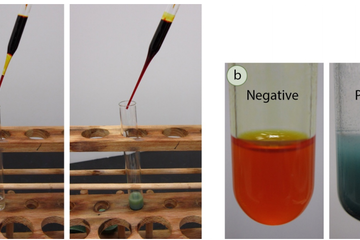We found 31 results that contain "green 1"
Posted on: #iteachmsu

Health concerns - test articles
Common Health Concerns
Understanding common health concerns and what can be done to prevent or treat them can go a long way towards reducing the stress you feel when it comes to your health and the health of those in your care.
Whether you have seen a health story on the news, your child has come home from school with a note about immunizations, or your teenage daughter wants to go to another country on an exchange program, you are looking for information to guide you through the steps toward making informed health decisions. Having easy to understand health information at your fingertips will help you to focus on the key facts and save time.
In this section, there are information topics about some of the most common health concerns, so it is easy for you to find what you are looking for as quickly as possible.
Understanding common health concerns and what can be done to prevent or treat them can go a long way towards reducing the stress you feel when it comes to your health and the health of those in your care.
Whether you have seen a health story on the news, your child has come home from school with a note about immunizations, or your teenage daughter wants to go to another country on an exchange program, you are looking for information to guide you through the steps toward making informed health decisions. Having easy to understand health information at your fingertips will help you to focus on the key facts and save time.
In this section, there are information topics about some of the most common health concerns, so it is easy for you to find what you are looking for as quickly as possible.
Authored by:
Chathuri

Posted on: #iteachmsu


Health concerns - test articles
Common Health Concerns
Understanding common health concerns a...
Understanding common health concerns a...
Authored by:
Friday, Nov 8, 2019
Posted on: #iteachmsu

PEDAGOGICAL DESIGN
How does Finland’s top-ranking education system work?
How does Finland’s top-ranking education system work?
Finland has been a top contender on every Program for International Student Assessment survey.
The country built a comprehensive education structure designed to offer citizens free education with no dead ends.
The inspiration for Finland's approach was American education research and philosophers such as John Dewey.
Finland's education system enjoys a lot of buzz lately. It is considered one of the best education systems in the world. It routinely outperforms the United States in reading, science, and mathematics. And it has been a top performer since the first Program for International Student Assessment (PISA) triennial international survey back in 2000.
But ask someone what's so great about Finland's schools, and you'll typically be supplied with a factoid or three. They have shorter school days. They don't do standardized tests. They all must be smart because the Finnish language is a nightmare.
While these facts are true — except for that last one — they miss Finland's well-raked forests for its trees. Finland's education system works because its entire structure has been around several core principles. First and foremost, equal access to education is a constitutional right. Another important principle is that one should be allowed to choose their educative path, which should never lead to a dead end.
Here's how Finland's education system works to meet those principles.
Finland has been a top contender on every Program for International Student Assessment survey.
The country built a comprehensive education structure designed to offer citizens free education with no dead ends.
The inspiration for Finland's approach was American education research and philosophers such as John Dewey.
Finland's education system enjoys a lot of buzz lately. It is considered one of the best education systems in the world. It routinely outperforms the United States in reading, science, and mathematics. And it has been a top performer since the first Program for International Student Assessment (PISA) triennial international survey back in 2000.
But ask someone what's so great about Finland's schools, and you'll typically be supplied with a factoid or three. They have shorter school days. They don't do standardized tests. They all must be smart because the Finnish language is a nightmare.
While these facts are true — except for that last one — they miss Finland's well-raked forests for its trees. Finland's education system works because its entire structure has been around several core principles. First and foremost, equal access to education is a constitutional right. Another important principle is that one should be allowed to choose their educative path, which should never lead to a dead end.
Here's how Finland's education system works to meet those principles.
Authored by:
Chathuri

Posted on: #iteachmsu


How does Finland’s top-ranking education system work?
How does Finland’s top-ranking education system work?
Finla...
Finla...
Authored by:
PEDAGOGICAL DESIGN
Wednesday, Oct 9, 2019
Posted on: #iteachmsu

ASSESSING LEARNING
Chemical testing overview
Overview
Before spectroscopic analysis (IR, NMR) became commonplace in the organic chemistry lab, chemical tests were heavily relied upon to support compound identification. A chemical test is typically a fast reaction performed in a test tube that gives a dramatic visual clue (a color change, precipitate, or gas formation) as evidence for a chemical reaction. For example, addition of an orange chromic acid reagent to some compounds causes the chromium reagent to change to a blue-green color (Figure 6.37a). This is considered a "positive" test result, and in this case indicates the presence of a functional group that can be oxidized (alcohol or aldehyde). A negative test result is retention of the original color of the reagent, in this case the orange color
Before spectroscopic analysis (IR, NMR) became commonplace in the organic chemistry lab, chemical tests were heavily relied upon to support compound identification. A chemical test is typically a fast reaction performed in a test tube that gives a dramatic visual clue (a color change, precipitate, or gas formation) as evidence for a chemical reaction. For example, addition of an orange chromic acid reagent to some compounds causes the chromium reagent to change to a blue-green color (Figure 6.37a). This is considered a "positive" test result, and in this case indicates the presence of a functional group that can be oxidized (alcohol or aldehyde). A negative test result is retention of the original color of the reagent, in this case the orange color
Authored by:
Chathuri

Posted on: #iteachmsu


Chemical testing overview
Overview
Before spectroscopic analysis (IR, NMR) becam...
Before spectroscopic analysis (IR, NMR) becam...
Authored by:
ASSESSING LEARNING
Monday, Aug 26, 2019
Posted on: Queens group

PEDAGOGICAL DESIGN
Biochemistry
Biochemistry is the application of chemistry to the study of biological processes at the cellular and molecular level. It emerged as a distinct discipline around the beginning of the 20th century when scientists combined chemistry, physiology, and biology to investigate the chemistry of living systems.
tets
1oufi'aofio
DFHAIHF
FGJIFI
lwa fo'i io iaof
afewof
'a foe
tets
1oufi'aofio
DFHAIHF
FGJIFI
lwa fo'i io iaof
afewof
'a foe
Authored by:
chathuri

Posted on: Queens group


Biochemistry
Biochemistry is the application of chemistry to the study of biolog...
Authored by:
PEDAGOGICAL DESIGN
Friday, Oct 11, 2019
Posted on: #iteachmsu

DISCIPLINARY CONTENT
Article with normal youtube URL
Normal Youtube URL 1:Normal Youtube URL 2:Normal Youtube URL 3:Normal Youtube URL 4:
Symptoms
Symptoms of a heart attack vary. Some people have mild symptoms. Others have severe symptoms. Some people have no symptoms.
Common heart attack symptoms include:
Chest pain that may feel like pressure, tightness, pain, squeezing or aching
Pain or discomfort that spreads to the shoulder, arm, back, neck, jaw, teeth or sometimes the upper belly
Cold sweat
Fatigue
Heartburn or indigestion
Lightheadedness or sudden dizziness
Nausea
Shortness of breath
Women may have atypical symptoms such as brief or sharp pain felt in the neck, arm or back. Sometimes, the first symptom sign of a heart attack is sudden cardiac arrest.
Some heart attacks strike suddenly. But many people have warning signs and symptoms hours, days or weeks in advance. Chest pain or pressure (angina) that keeps happening and doesn't go away with rest may be an early warning sign. Angina is caused by a temporary decrease in blood flow to the heart.
Symptoms
Symptoms of a heart attack vary. Some people have mild symptoms. Others have severe symptoms. Some people have no symptoms.
Common heart attack symptoms include:
Chest pain that may feel like pressure, tightness, pain, squeezing or aching
Pain or discomfort that spreads to the shoulder, arm, back, neck, jaw, teeth or sometimes the upper belly
Cold sweat
Fatigue
Heartburn or indigestion
Lightheadedness or sudden dizziness
Nausea
Shortness of breath
Women may have atypical symptoms such as brief or sharp pain felt in the neck, arm or back. Sometimes, the first symptom sign of a heart attack is sudden cardiac arrest.
Some heart attacks strike suddenly. But many people have warning signs and symptoms hours, days or weeks in advance. Chest pain or pressure (angina) that keeps happening and doesn't go away with rest may be an early warning sign. Angina is caused by a temporary decrease in blood flow to the heart.
Symptoms
Symptoms of a heart attack vary. Some people have mild symptoms. Others have severe symptoms. Some people have no symptoms.
Common heart attack symptoms include:
Chest pain that may feel like pressure, tightness, pain, squeezing or aching
Pain or discomfort that spreads to the shoulder, arm, back, neck, jaw, teeth or sometimes the upper belly
Cold sweat
Fatigue
Heartburn or indigestion
Lightheadedness or sudden dizziness
Nausea
Shortness of breath
Women may have atypical symptoms such as brief or sharp pain felt in the neck, arm or back. Sometimes, the first symptom sign of a heart attack is sudden cardiac arrest.
Some heart attacks strike suddenly. But many people have warning signs and symptoms hours, days or weeks in advance. Chest pain or pressure (angina) that keeps happening and doesn't go away with rest may be an early warning sign. Angina is caused by a temporary decrease in blood flow to the heart.
Symptoms
Symptoms of a heart attack vary. Some people have mild symptoms. Others have severe symptoms. Some people have no symptoms.
Common heart attack symptoms include:
Chest pain that may feel like pressure, tightness, pain, squeezing or aching
Pain or discomfort that spreads to the shoulder, arm, back, neck, jaw, teeth or sometimes the upper belly
Cold sweat
Fatigue
Heartburn or indigestion
Lightheadedness or sudden dizziness
Nausea
Shortness of breath
Women may have atypical symptoms such as brief or sharp pain felt in the neck, arm or back. Sometimes, the first symptom sign of a heart attack is sudden cardiac arrest.
Some heart attacks strike suddenly. But many people have warning signs and symptoms hours, days or weeks in advance. Chest pain or pressure (angina) that keeps happening and doesn't go away with rest may be an early warning sign. Angina is caused by a temporary decrease in blood flow to the heart.
Posted by:
Venturit Super Admin
Posted on: #iteachmsu

Article with normal youtube URL
Normal Youtube URL 1:Normal Youtube URL 2:Normal Youtube URL 3:Norm...
Posted by:
DISCIPLINARY CONTENT
Wednesday, May 15, 2024
Posted on: #iteachmsu

DISCIPLINARY CONTENT
Article with multiple embedded video URLs
Embedded video URL 1:Embedded video URL 2: Embedded video URL 3: Embedded video URL 4:Embedded video URL 5:
Symptoms
Symptoms of a heart attack vary. Some people have mild symptoms. Others have severe symptoms. Some people have no symptoms.
Common heart attack symptoms include:
Chest pain that may feel like pressure, tightness, pain, squeezing or aching
Pain or discomfort that spreads to the shoulder, arm, back, neck, jaw, teeth or sometimes the upper belly
Cold sweat
Fatigue
Heartburn or indigestion
Lightheadedness or sudden dizziness
Nausea
Shortness of breath
Women may have atypical symptoms such as brief or sharp pain felt in the neck, arm or back. Sometimes, the first symptom sign of a heart attack is sudden cardiac arrest.
Some heart attacks strike suddenly. But many people have warning signs and symptoms hours, days or weeks in advance. Chest pain or pressure (angina) that keeps happening and doesn't go away with rest may be an early warning sign. Angina is caused by a temporary decrease in blood flow to the heart.
Symptoms
Symptoms of a heart attack vary. Some people have mild symptoms. Others have severe symptoms. Some people have no symptoms.
Common heart attack symptoms include:
Chest pain that may feel like pressure, tightness, pain, squeezing or aching
Pain or discomfort that spreads to the shoulder, arm, back, neck, jaw, teeth or sometimes the upper belly
Cold sweat
Fatigue
Heartburn or indigestion
Lightheadedness or sudden dizziness
Nausea
Shortness of breath
Women may have atypical symptoms such as brief or sharp pain felt in the neck, arm or back. Sometimes, the first symptom sign of a heart attack is sudden cardiac arrest.
Some heart attacks strike suddenly. But many people have warning signs and symptoms hours, days or weeks in advance. Chest pain or pressure (angina) that keeps happening and doesn't go away with rest may be an early warning sign. Angina is caused by a temporary decrease in blood flow to the heart.
Posted by:
Venturit Super Admin
Posted on: #iteachmsu

Article with multiple embedded video URLs
Embedded video URL 1:Embedded video URL 2: Embedded video URL ...
Posted by:
DISCIPLINARY CONTENT
Wednesday, May 15, 2024
Posted on: #iteachmsu

ASSESSING LEARNING
History of Agile -- edited
In 1957, people started figuring out new ways to build computer programs. They wanted to make the process better over time, so they came up with iterative and incremental methods.
In the 1970s, people started using adaptive software development and evolutionary project management. This means they were adjusting and evolving how they built software.
In 1990s, there was a big change. Some people didn't like the strict and super-planned ways of doing things in software development. They called these old ways "waterfall." So, in response, lighter and more flexible methods showed up.
In the 1970s, people started using adaptive software development and evolutionary project management. This means they were adjusting and evolving how they built software.
In 1990s, there was a big change. Some people didn't like the strict and super-planned ways of doing things in software development. They called these old ways "waterfall." So, in response, lighter and more flexible methods showed up.
Posted by:
Scarlet Ethan Edien

Posted on: #iteachmsu


History of Agile -- edited
In 1957, people started figuring out new ways to build computer pro...
Posted by:
ASSESSING LEARNING
Wednesday, Jul 30, 2025
Posted on: #iteachmsu

NAVIGATING CONTEXT
Why are my cholesterol numbers important? -- Additionally added and edited
Your cholesterol numbers are important because they help you know your risk for heart disease. Cholesterol is a type of lipid (fat) that helps your body perform many important functions. But too much cholesterol in your blood is bad for you. It can enter your artery wall, damage its integrity and lead to the formation of atherosclerotic plaque (hardened deposits).
This process of plaque buildup is called atherosclerosis. It can lead to serious problems like:
Coronary artery disease: Blocked blood flow to your heart.
Peripheral artery disease: Blocked blood flow to your legs and arms.
Carotid artery disease: Blocked blood flow to your brain.
Cholesterol travels through your blood silently. And it turns into plaque silently. Plaque buildup is like someone tip-toeing on carpet. You might not see or notice its presence for a long time. You may have no symptoms until you have a heart attack or stroke. At that point, the plaque is like high heels on a hardwood floor. And it’s already caused serious damage to your body.
You can live for many years with high cholesterol and not even know it. That’s why it’s essential to get your cholesterol numbers checked on a regular basis. If your cholesterol numbers are too high (hyperlipidemia), that’s a red flag for you and your healthcare provider. High cholesterol is a major risk factor for heart disease. But catching it early gives you a chance to make changes and get your cholesterol to a healthy level.
This process of plaque buildup is called atherosclerosis. It can lead to serious problems like:
Coronary artery disease: Blocked blood flow to your heart.
Peripheral artery disease: Blocked blood flow to your legs and arms.
Carotid artery disease: Blocked blood flow to your brain.
Cholesterol travels through your blood silently. And it turns into plaque silently. Plaque buildup is like someone tip-toeing on carpet. You might not see or notice its presence for a long time. You may have no symptoms until you have a heart attack or stroke. At that point, the plaque is like high heels on a hardwood floor. And it’s already caused serious damage to your body.
You can live for many years with high cholesterol and not even know it. That’s why it’s essential to get your cholesterol numbers checked on a regular basis. If your cholesterol numbers are too high (hyperlipidemia), that’s a red flag for you and your healthcare provider. High cholesterol is a major risk factor for heart disease. But catching it early gives you a chance to make changes and get your cholesterol to a healthy level.
Authored by:
Vijaya

Posted on: #iteachmsu


Why are my cholesterol numbers important? -- Additionally added and edited
Your cholesterol numbers are important because they help you know y...
Authored by:
NAVIGATING CONTEXT
Wednesday, Apr 3, 2024


